Anyone who’s started a colorful freshwater aquarium has dreamed about adding a school of discus to their tank.
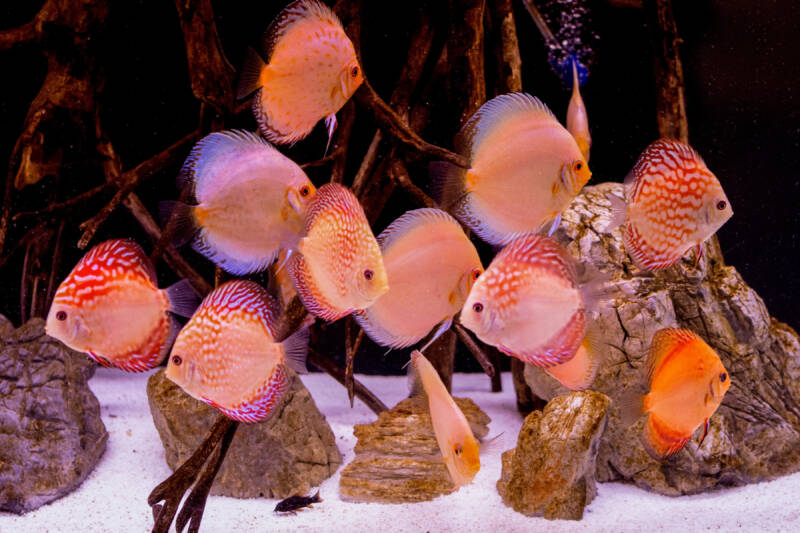
These unique members of the Cichlidae family represent the pinnacle of aquarium prowess – which is why they get referred to as “Kings of the Aquarium.”
Courtesy of selective breeding, you can find any color you desire – in more vivid shades than you see in nature.
And the horizontal and vertical striping extends to their fins. Combined with their flattened disc-like shape, they’re something to behold.
But discus aren’t for the novice aquarist. That “King of the Aquarium” title also refers to the difficulty of their keeping.
With the slightest slip-up in care, you’ll find yourself with discus turning black and passing away.
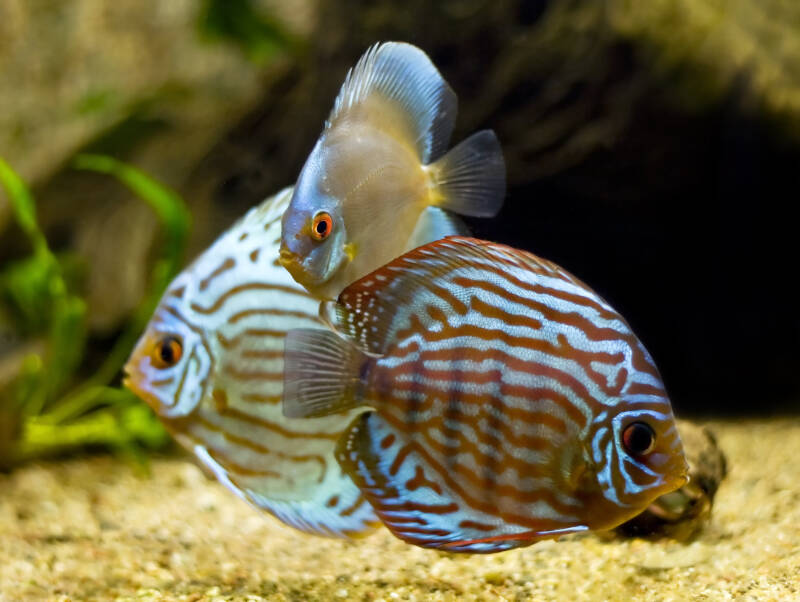
But if you’ve mastered your aquarium techniques and feel confident in your abilities, you couldn’t ask for a more gorgeous fish.
And with so much variety to choose from, you’ll find yourself with a stunning discus tank – the envy of everyone around you.
At a Glance
| Min. Tank Size: | 75 gallons (284 l) |
| School Size: | 5 or More |
| Temperature: | 82-86°F (28-30°C) |
| Lifespan: | 10 years |
| Size: | 8-10 inches (20-25 cm) |
| pH: | 6.0-7.0 |
| Hardness: | 1-4 dH |
| Ammonia: | 0 ppm |
| Nitrite: | 0 ppm |
| Nitrate: | 0-10 ppm |
[toc]
In the Wild
Discus inhabit the flooded forests and lakes in the Amazon river basin.
The dramatic flood pulse in the region lifts and lowers the water height by feet/meters at a time. The pulse allows the discus to grow larger while enjoying more room for spawning and feeding.
They prefer the sandy sediment and pockets around galhadas or fallen trees.
The submerged trunks break up the water flow, allowing their wide-body shape to enjoy a much slower current (they’re not the fastest swimmers).
Three species inhabit the basin:
- Common discus (Symphysodon aequifasciatus) sticks to Brazil, Colombia, and Peru.
- Heckel’s discus (S. discus) prefers the Abacaxis, Rio Negro, and Tromebtus Rivers.
- Red-spotted green discus (S. tarzoo) stays in the western Amazon.
Most wild discus sport red eyes – prompting a myth that the crimson color signals good health. However, the flattened fish have eyes that come in a variety of colors.
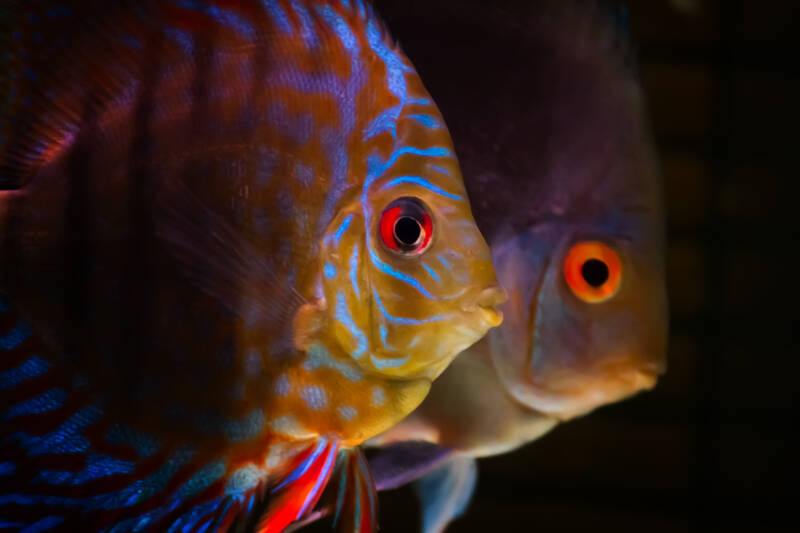
If the eyes remain proportional to the rest of the body, the fish is considered healthy with sound genetics.
Depending on their age, the variety of their diet, the water conditions present, and the level of stress a fish is feeling, discus CAN change colors. They also show abilities to blend into their surroundings.
Size: Taking Up the Tank
One of the challenges discus present for aquarists is their size. When they reach full size, they can stretch between 8-10 inches (20-25 cm) long.
They’re slow to grow – slower than other freshwater species – but if you don’t plan appropriately, they’ll soon eclipse your tank.
Lifespan
Under the best management, discus live around ten years. With excellent care and diet, you can see them extend that lifespan up to 15 years (something that doesn’t happen as frequently as one might imagine).
However, with their slow growth, discus don’t see the full potential of their vibrant coloration until they reach six years old.
So if you’re disappointed in the shades of your “juvenile” discus, give them a few years. They’re still reaching their potential.
Behavior
Compared to other cichlids, discus have a peaceful nature. The lack of a strong swimming ability leaves them on the shyer end of the scale.
They prefer to duck into hiding rather than attempting to intimidate other fish (despite their impressive size).
However, they ARE still cichlids. Within their school, you’ll see them exhibit competition while they set up their preferred pecking order. And the smallest in the group may end up missing out on food as a result.

The best way to avoid this problem is to purchase your entire school at ONCE. This way, you can select discus that are roughly the same size.
You can observe their interactions and single out potentially aggressive shoal members for rehoming (or move them to another tank).
Discus MUST remain in schools of at LEAST five. They’re social freshwater fish. If they’re left in small numbers (or alone), they’ll become stressed and hide.
Or, worse, you’ll start to see them turning BLACK. A black discus is ALWAYS a bad sign.
The best school will include one or two males, with the remainder composed of females.
Males have more of an aggressive streak, especially during the spawning season. As long as the fish are the same size and came into the tank at once, you shouldn’t see any problems.
Tank Setup

Due to the impressive size and the need to keep a relatively large school, you can’t skimp on aquarium size. Discus need ROOM.
As such, you’ll want a minimum of a 75-gallon (284 l) tank. And, honestly, bigger is ALWAYS better when it comes to these cichlids.
As you’ll see in a minute, discus have extreme sensitivities to water conditions.
Managing water quality is easier with larger tanks. So going up to 100 gallons (378 l) or HIGHER will make your life easier. A good rule? For every discus you add, add 7 gallons (26 l) of water.
Next, make sure you have a high-quality filter. Canister filters work best for discus.
They allow the most surface area for friendly bacteria to grow without overdoing the water outflow.
They also work best on tall tanks, which function well with discus.
Water Conditions
In the Amazon floodplains, discus inhabit soft, acidic water. You want water temperatures around 82-86F (28-30C). This keeps your discus active, with a healthy metabolism.
Warm water isn’t oxygen-rich, though, so you’ll need supplemental air stones to make up the difference.
You also want that acidic water, with a pH of 6.0-7.0.
And you need SOFT water. Discus are used to ranges between 1-4dH. Some aquarists use reverse osmosis filters to help them meet these demands. Others? They tackle frequent water changes.
You don’t have to perform daily water changes—however, discus DEMAND pristine water quality.
Your ammonia and nitrites CAN’T go above 0 ppm. You’ll see your fish turn black as a result. And even 10ppm of nitrates can get to be too much.
Twice weekly water changes of 40% MAY get you through – depending on the size of your tank. Other people use one weekly 50% water change. You’ll know what you can manage based on FREQUENT water quality testing.
Water changes remove waste from the aquarium. So daily water changes only become necessary if your tank is small (too small), you have too many fish, you’re feeding too much, you don’t use biological filtration, or you don’t have live plants.
Decorating the Discus Tank
Setting up your discus tank is about making them comfortable, aesthetics, AND those pesky water change considerations. (See why discus are challenging to keep?) Every choice on what you put in the tank ripples through their care.
Many aquarists opt for bare-bottom tanks. With nothing to collect waste, you can cut back on how often you need to perform water changes.
However, discus like to forage along the substrate. So you end up depriving them of normal behaviors.
Sand and gravel often trap dissolved food and waste. You allow your discus to enjoy an environment similar to their natural habitat, though.
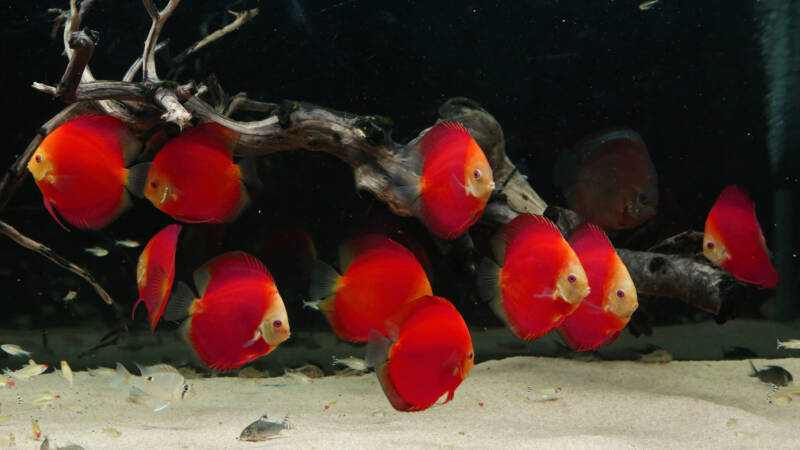
And as long as you’re dutiful in vacuuming the bottom of the tank, there’s no problem.
Some aquarists compromise by using tank tiles or large rocks. The aquarium looks better than a bare bottom, but there’s no worry of uneaten food or waste getting trapped in the substrate. You’ll have to decide what works best for you.
Driftwood anchored in the vertical position provides hiding places for your discus. It also softens the outflow from your filters.
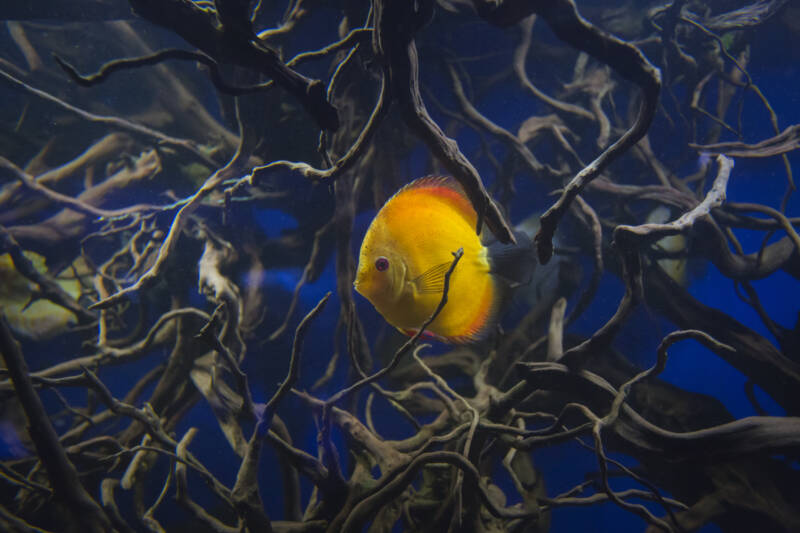
You want to sand down any sharp edges, though. Discus have a thick mucus coat, and you don’t want them to get injured.
Plants go a long way to supplementing oxygen AND aiding with removing unwanted wastes from the water.
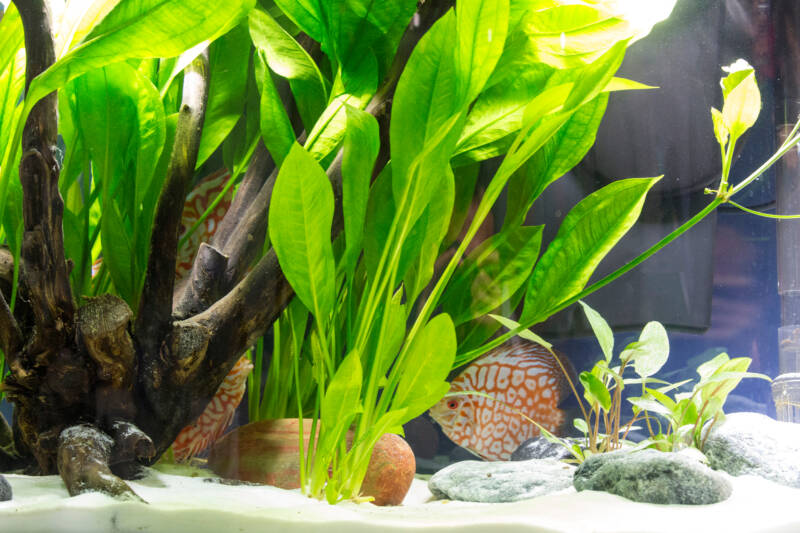
However, it’s tricky to find species that tolerate warm water, low lighting, and a slightly acidic condition. But there ARE some that work:
- Amazon sword
- Anubias
- Bacopa
- Dwarf hairgrass
- Micro sword.
Set up the tallest plants at the back of the tank. You can then move to the shorter ones in the front. This allows your discus room to swim but also places to hide when they feel uncomfortable. It’ll also set up a stunning look for the aquarium.
Discus in Communities
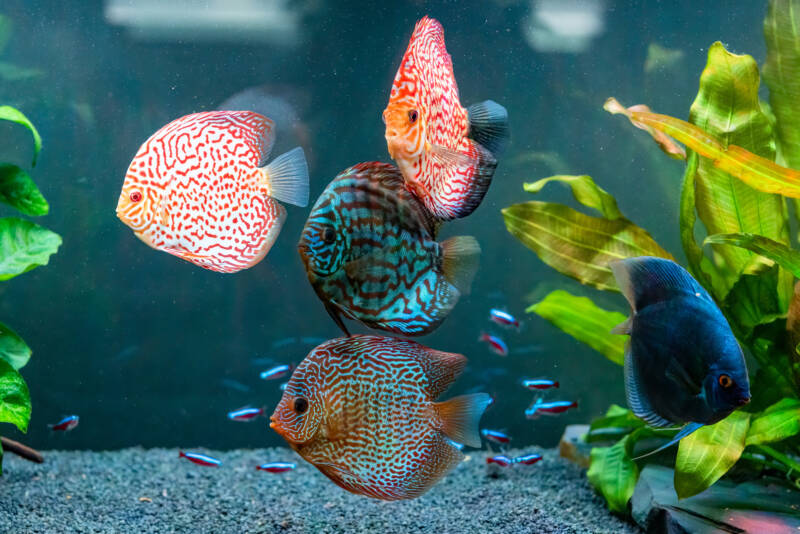
With so many variables to focus on, most aquarists keep discus in single-species tanks.
This is fine as you can combine all three species to get colorful displays. But they CAN incorporate into communities without too much trouble.
Tank Mates
If you take inspiration from the Amazon region, you’ll find plenty of dither fish that work well with discus.
The small schooling fish leave the larger discus feeling comfortable enough to cruise all tank levels, lowering their stress levels. These include:
- Apistogrammas
- Bolivian ram
- Cardinal tetras
- Clown loaches
- Emperor tetras
- Neon tetras
- Rummy nose tetras
- Ram cichlids.
You can also look for other fish that show the same tolerance for warm, slightly acidic waters.
As long as they have a similar temperament, discus do well. These include such species as:
- Gouramis
- Pencil fish
- Sterbai corydoras.
And as long as your snails and shrimp won’t fit into the teeny-tiny discus mouth, you’re in the clear.
They’ll leave most invertebrates alone as they explore the different levels of the tank. It gives you another option for your community.
Incompatible Species
Despite their size, discus lack the temperament to compete with aggressive fish.
Even their cousins, the angelfish, present problems. Angelfish often decide to bully them, mustering enough swimming speed to snatch away food.
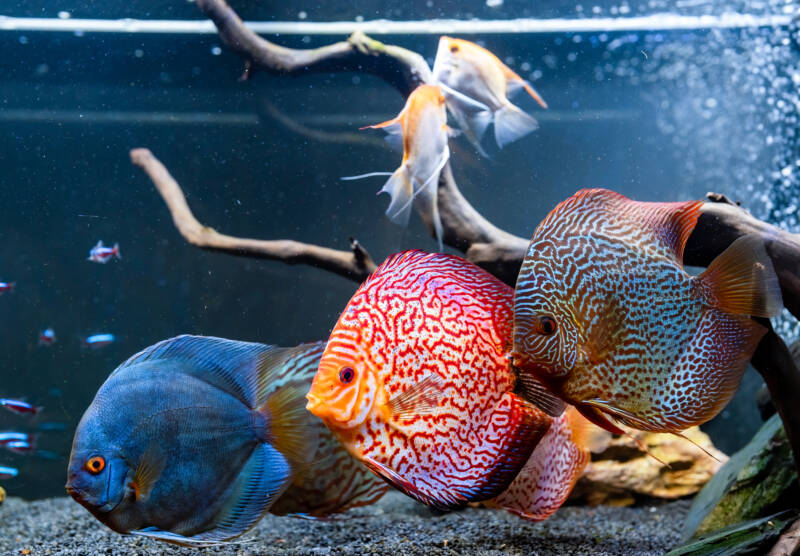
This is why you need to consider swimming speed when setting up a community.
Silver dollars may share the Amazon, but they swim FAST. They’re too quick-moving and out-compete discus for food, leaving the larger fish starving.
Other aggressive fish go after the thick mucus coat on the discus. Once the coat is damaged, bacteria can invade, leading to infection. This means you may see your discus turning black – either due to the infection or the attacks’ stress.
Food and Diet
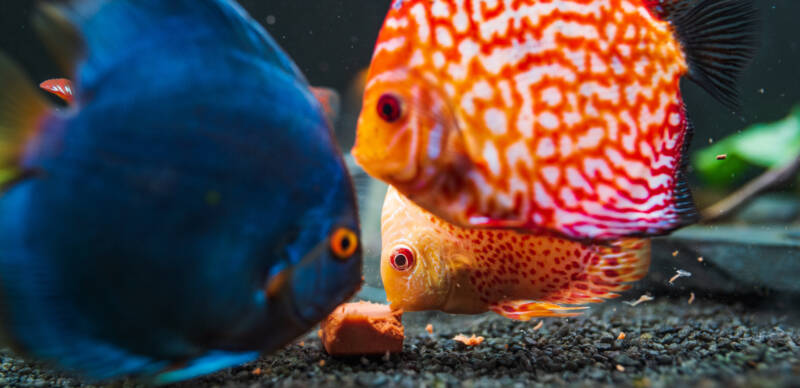
As with most cichlids, discus order from the omnivore menu.
This makes them easy to feed – provided they’re able to get to the food. You need to observe the tank and make sure your discus get the nutrition you provide.
While certainly not small fish, discus have very tiny mouths.
You may see them take a bite, spit it out, and then try again. That’s not a picky fish. It means the size of the offered food is too large, and they’re struggling. You need to cut things down.
Discus do fine with commercial fish foods. Many companies cater to discus: Sera Discus Granules, Tetra Discus Granules, and Hikari Discus Bio-Gold. You don’t want to make prepared diets their entire meal, though.
Plenty of aquarists use beef hearts as a source of protein. It isn’t HARMFUL, but there aren’t many cows falling into the Amazon with their rib cages exposed, either.
You’re much better off sticking to natural sources of protein for your discus to avoid excess fat:
- Blackworms
- Bloodworms
- Brine shrimp
- Mosquito larvae
- White worms.
Breeding Your Discus: For Fun and Profit?
If you want to tackle breeding discus, prepare to invest time, effort, and additional costs.
You’ll need a separate tank – complete with the same pristine water conditions. And if you slip up, you’ll lose the fry – or the parents.
Males or Females?
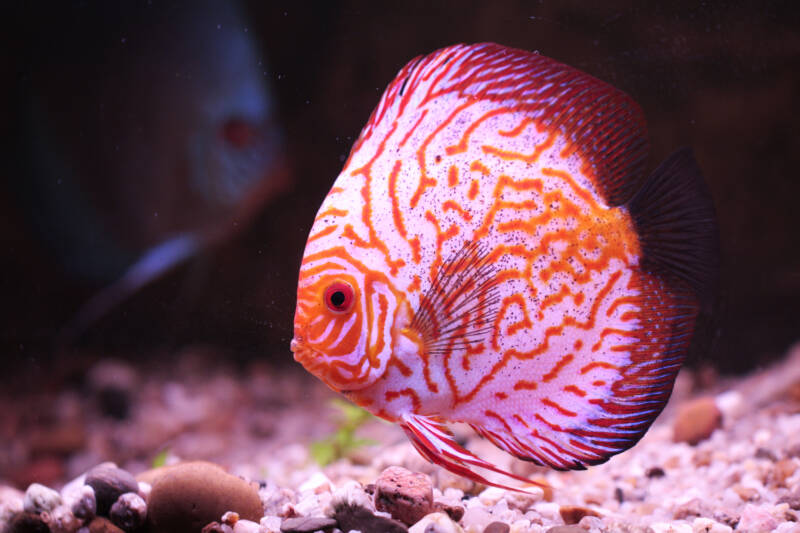
Similar to angelfish, you can’t look at a discus and know at a glance whether you have a male or female. You need to wait for the spawning season and check for the breeding tubes to get your confirmation.
First, the fish MUST be at least 5.5 inches (14 cm) long before you have any hope of successfully sexing them.
Then check the tubes. On females, the breeding tube has a blunt end and is wider. Males have a thinner breeding tube that comes to a point.
The Mucus Coat
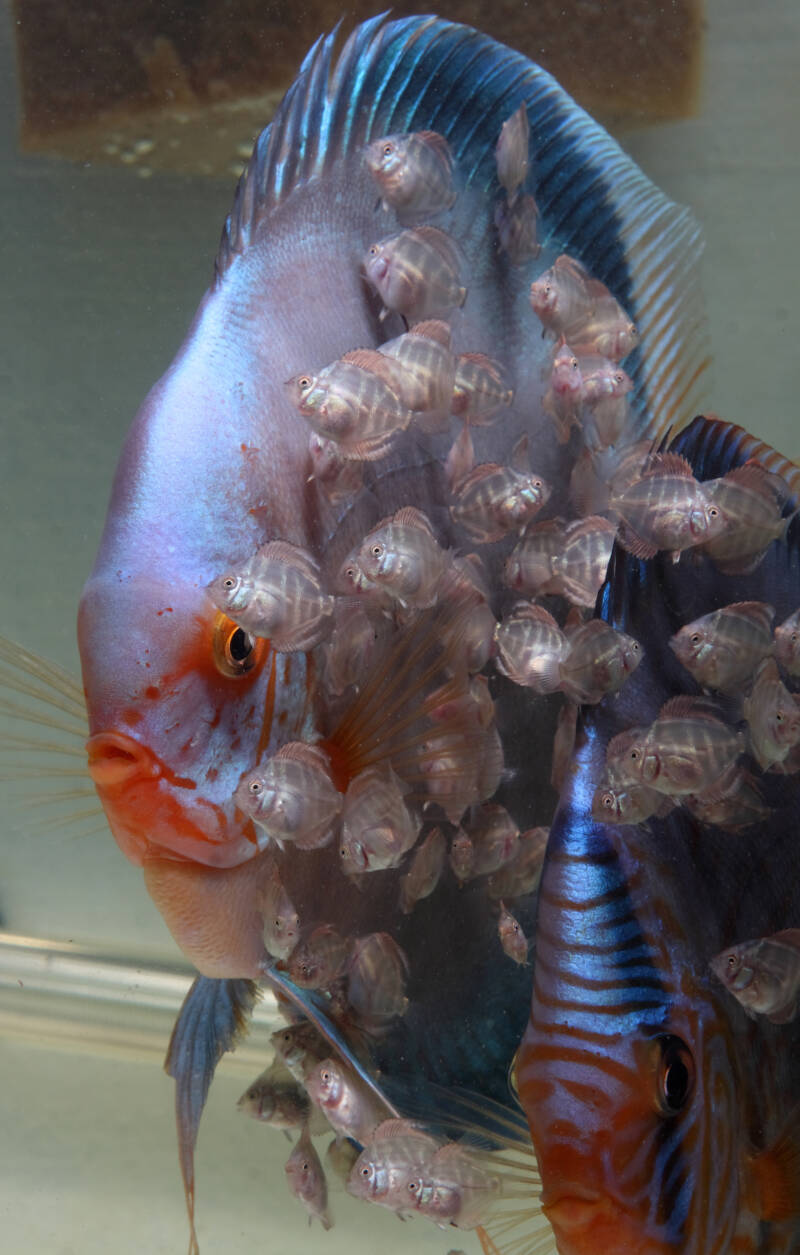
The first spawning of a pair of discus usually fails. The parents tend to eat the eggs. Of course, they’re generally in a community tank, so that’s often a stress reaction.
If you want to avoid that result, you need a separate tank of at least 55 gallons (208 l).
In addition to getting the water perfect, you need to cover the three sides of the tank with either white or blue. This will help the fry find the parents once they hatch.
You also need to cover the intake of the filter to prevent fry from getting sucked in.
If you’re using a sump in your tank, tuck it close to the heater. This prevents the discus parents from using the heater as a place to lay their eggs. (Eggs and heaters result in fried eggs)
Finally, offer the parents a spawning cone.
Two weeks of quality live food will stimulate the spawning process. And you’ll know you’re on track when you see them picking at the cone to get it cleaned and prepped. Once satisfied, the female lays a row of eggs for the male to fertilize.
The process continues until the female finishes, and it’s a delicate time. You DON’T want to pop by to observe. If the parent discus get stressed, they’ll stop and eat the eggs.
After three days, the eggs hatch, and the parents start caring for them.
Discus fry feed on their parents’ mucus coat. And without that white or blue coating of the tank walls? They can’t find them.
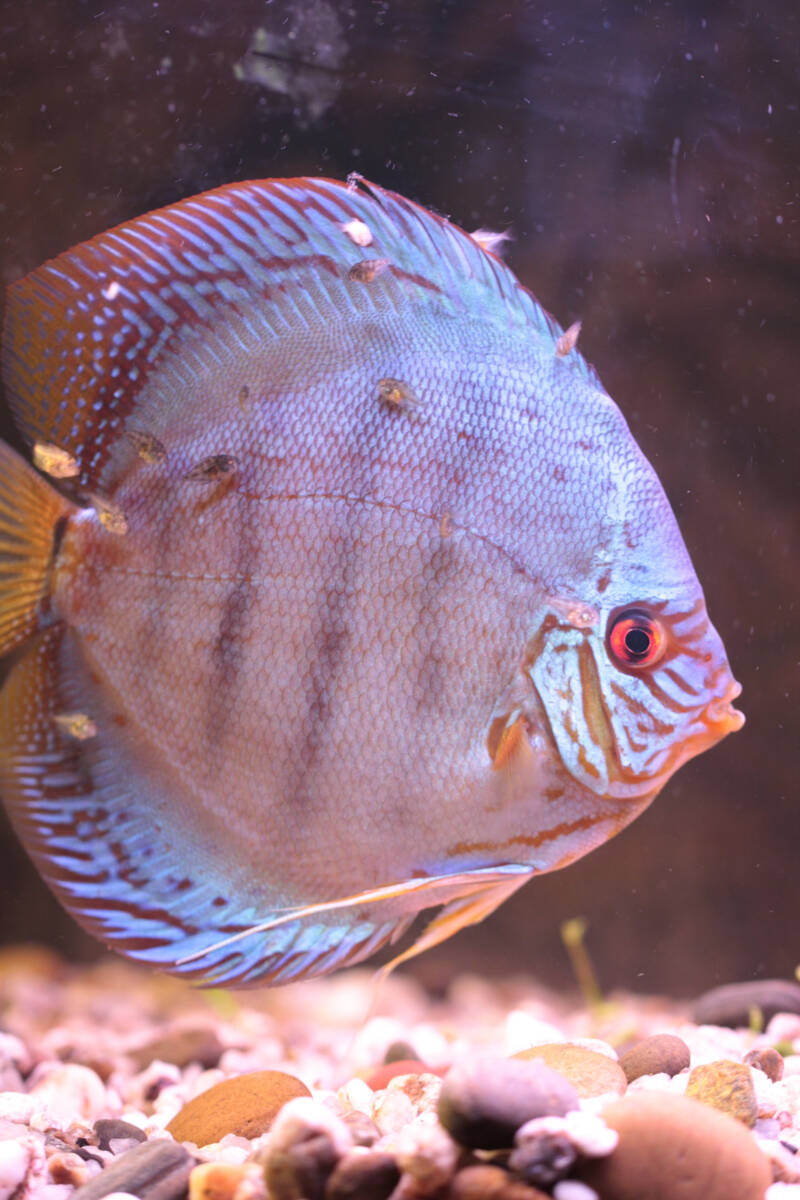
During the first few days, the parents move the fry around the aquarium. (So no panicking that they’re dead – they’re probably fine and somewhere else)
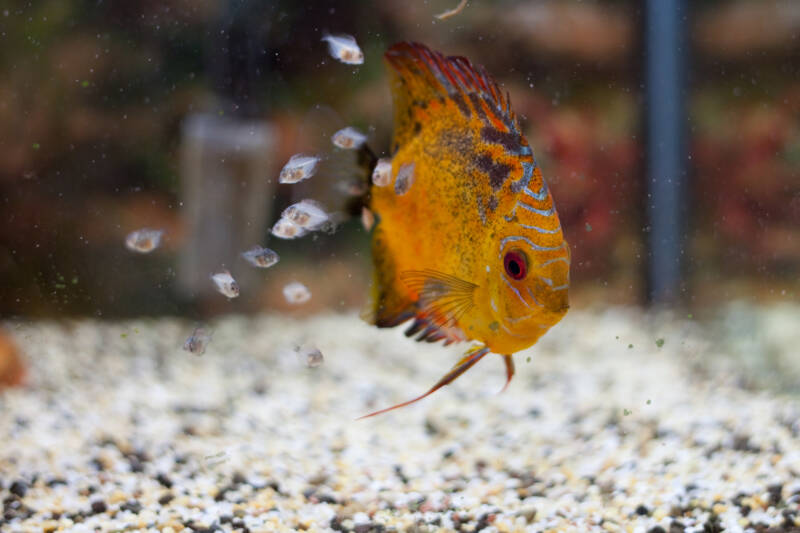
Once free-swimming, you can start to offer tiny pieces of bloodworms, beef hearts, or newly-hatched brine shrimp.
And you MUST perform daily water changes of 50-60%. Discus fry produce TONS of waste, and they’re even MORE sensitive than the parents.
If you’ve done your job, you can consider selling your baby discus when they reach 2 inches (5 cm) in length. This will take around 12-16 weeks, which means putting in LOTS of work and effort to reach that point.
Health
With all of their exacting demands, it’s not too surprising that discus also come with some health challenges.
And when you see your discus turning black? You know you have a problem. Stress, poor water conditions, and declining health bring on this unhealthy color change.
And the most common health problems seen in discus usually circle around poor water quality and management:
- Cloudy Eye: Filmy covering of one or both eyes. It can come from bacterial, fungal, or parasitic causes, but usually due to poor water conditions.
- Fin Rot: Decay of the fins. Left untreated, secondary infections result.
- Hexamita: This parasite produces slimy, white feces and weight loss.
- Hole in the Head: Poor diet or water quality leads to an opening in the fish’s forehead.
- Skin/Gill Flukes: Without proper tank cleaning, these parasites gain a foothold and begin affecting your discus’s breathing.
- Tapeworms: You start to see segmented feces.
Discus: Are They for You?
Discus show up in most fish stores, but the most unusual colors? You’ll need to hit the internet to find those.
And pricing ranges anywhere from $20-$300, depending on what you’re looking for. Sometimes you can see photos or videos of your intended fish, but other times you can’t.
Why do discus fetch such high prices? The difficulty of maintaining AND breeding them drives up the cost.
And since you MUST keep them in schools, breeders find themselves managing large aquariums – not to mention those separate breeding tanks.
Before you make a discus purchase, use some common sense. You don’t want to go for the cheapest one on the market. You also don’t want to break the bank – no matter how spectacular. Somewhere in the middle makes the most sense.
You also want to find a breeder with a healthy reputation. You should have a chance to examine the discus and check for these vital signs:
- Shape: Discus need a round shape.
- Eyes: Color doesn’t matter, but clearness and round shape DO. They also need to have a proper proportion to the body. Too large or small suggest something wrong with the genetics.
- Forehead: A nice circle shape free of dents or holes.
- Fins: The fins should form a semi-circle around the body. You don’t want any sign of fin rot.
- Color: You shouldn’t see black splotches that indicate stress or illness.
Kings of the Aquarium
With a lengthy list of must-haves, discus make life difficult for their aquarists. And they certainly aren’t for the faint of heart.
But if you’re up to the task, they’re some of the most beautiful fish available. Definitely worth the trouble they case.
Have you risked keeping discus? How often do you perform your water changes?
Do you feed them beef hearts or not?
Let us know your stories and questions here!
